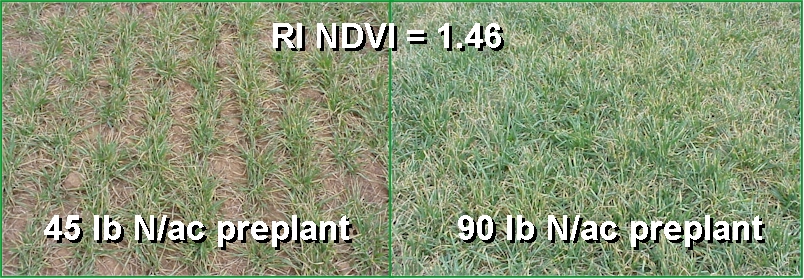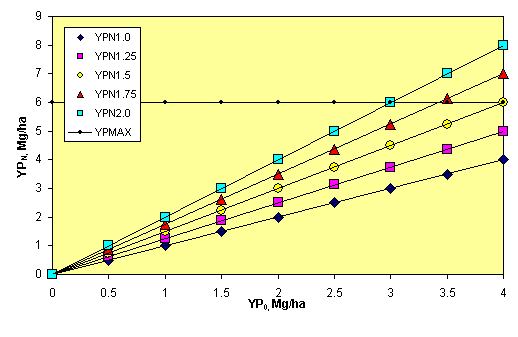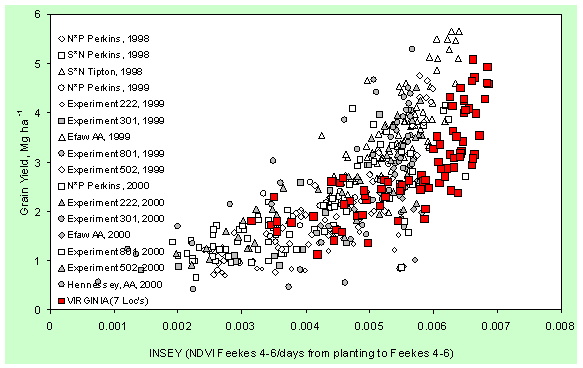 Response Index (RI)
Response Index (RI)
Response index computed by dividing the mid-season NDVI measurement from the Non-N Limiting (90 to 120 lb N/ac preplant in wheat, and 150 to 250 lb N/ac in corn) divided by the common farmer practice where less N is applied preplant. In the example above, the response index is determined by dividing the NDVI from the 90 lb N/ac preplant plot by the NDVI value in the 45 lb N/ac preplant.
_files/nrich.jpg)
_files/NLS_No3.gif)
Figure 1. Relationship bettwen RIHarvest and RINDVI over 62 locations from 1998 to 2003.
_files/NLS_No1.gif)
Figure 1. Wheat grain yield from 1971 to 2003 from long-term experiment #502, near Lahoma, OK from the check plot where no N has been applied since 1971 (0-40-60), and the non-N limiting plot that has received 100 lb N/ac every year (100-40-60). Note that in 2002, near maximum yields were produced in the check plot, a product of an extremely warm and wet winter resulting in significant quantities of N mineralized from soil organic matter.
Definitions
INSEY
In Season Estimated Yield = NDVI (Feekes 4 to 6)/days from planting
to sensing (days with GDD>0) = YP0
GDD
Growing Degree Days = (Tmin + Tmax)/2 – 4.4°C
RINDVI
= NDVI from plots receiving adequate but not excessive
preplant N, divided by NDVI from the farmer check (specific to that field)
where preplant N may or may not have been applied.
RIHARVEST
= Maximum observed grain yield (treatment average with N
fertilizer) divided by the observed grain yield from plots where no N was
applied either preplant or topdress
RISV
= Estimate of RI (spatial variability), using the average NDVI
value from a random sensor sample (100 m in length) collected in a farmers
field + 1 standard deviation, divided by the average NDVI value minus 1
standard deviation.
YPMAX
= Maximum obtainable yield level for a specific environment
determined by the farmer, or previously defined as a biological maximum by
research agronomists for that crop, and for that region (units: Mg/ha)
YP0
= Predicted or potential yield based on growing conditions up to
the time of sensing, that can be achieved with no additional (topdress) N
fertilization (units: Mg/ha)
YPN
= Predicted or potential yield that can be achieved with
additional (topdress) N fertilization based on the in-season response
index (RINDVI) (units: Mg/ha)
= (YP0)/ (1/RINDVI)
=
(YP0)*(RINDVI)
PNG
= Percent nitrogen in the grain estimated from multiple
observations, over years, using various different wheat varieties (likely
to be region specific) (units: %)
GNUP
= Predicted grain N uptake (predicted percent N in the grain
multiplied times YPN/1000) (units: kg/ha)
FNUP
= Predicted forage N uptake estimated from the calibrated
relationship with NDVI (units:
kg/ha)
FNR
= Fertilizer nitrogen requirement estimated by subtracting
predicted forage N uptake (FNUP) from predicted grain N uptake (GNUP)
(units: kg/ha)
Restrictions
YPN
cannot be > YPMAX

Figure
1. Predicted yield achievable
with added N fertilization (YPN) based on RINDVI as
a function of predicted yield that can be achieved with no added N
fertilization (YP0), where YPN = (YP0)/ (1/RINDVI).
 |
